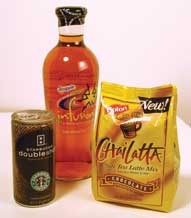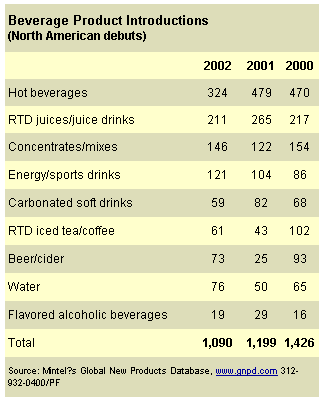
- Flavor, flavor, flavor.
- Enriching tea and coffee.
- FAB now DOA?
- Soft drink makers diversify.
Havana Cappuccino, Ocean City, N.J., added several iced cappuccino varieties with no added sugar and no caffeine. Meanwhile, PepsiCo's, Purchase, N.Y., and Starbucks Coffee's, Seattle, joint venture North American Coffee Partnership helped to bring Starbucks onto even more store shelves with the Starbucks DoubleShot Espresso & Cream coffee drink.
Adding some vitamin enrichment to the category, Fuze VitaminTea contains 100% of the daily values of vitamins A, C, E, B3, B5, B6 and B12. VitaminTea launched a green tea with ginseng flavor, which was joined by flavor extensions into diet peach and iced tea with lemon.
Ginseng also was incorporated into Energy+Infusion juice-infused tea from Snapple Beverages, White Plains, N.Y., though this blend of mango-tangerine juice and brewed tea also featured guarana and ginkgo biloba.
On the less-adventuresome side, healthful iced coffee introductions stayed the course of reduced fat, calories or sugar. However, some enrichment is making its way to the shelf. Iced Coffee Plus from Planet Java, Queens, N.Y., had two new flavors. The vanilla-flavored MOJO-vation was described as a good source of potassium and magnesium, while Cara-MEAL was a rich dulce de leche caramel coffee drink enriched with 16 vitamins and minerals.
We've Got Spirit
On the spirits and liqueurs side, new flavor varieties and packaging are bestowing a fresher image to vodka, but that has failed to spread to other areas of the sub-category, as whisky and vodka account for most product introductions.Significant whisky introductions centered on the packaging. Crown Royal Special Reserve Canadian Whisky from Seagram, New York, is now in a vibrant gold- and violet-colored carton, though the trademark velvet outer bag remained unchanged. Meanwhile, a plastic bottle was a new route for Hiram Walker & Sons', Manchester, Mich., Rich & Rare Canadian Whisky.
One dark spirit has managed to lure the younger adult consumer, as spiced rum had a number of interesting launches. Bacardi-Martini USA's, Miami, Bacardi Ciclón is a gold Puerto Rican rum infused with imported blue agave tequila and natural lime flavor with 35% alcohol by volume (ABV). That company teamed up with Coca-Cola, Atlanta, for an interesting launch in the U.K. The Bacardi & Coke Pack has a 350ml bottle of Bacardi white rum and four 330ml classic Coca-Cola bottles.
A variety of flavors graced vodka bottles this year as well. Luctor International, Reno, Nev., introduced Van Gogh's Circle of Flavors in four varieties, including dutch chocolate vodka and “wild appel vodka.” Diageo, Miami, added to its line of flavored vodkas with Smirnoff Green Apple Twist.

Hot in Here
Organic offerings played a notable role in 2002 hot beverage introductions, as coffee giant Starbucks introduced in its shops Serena Organic Blend in three varieties—milk, smooth and bold—part of its private label offerings. Safeway, Pleasanton, Calif., took a similar route in its private label Safeway Select line, adding an organic variety of its whole bean coffee.While not held in such high esteem (healthfully) as green tea, other hot beverages are making headway in that regard, particularly with the launches of herbal teas, decaffeinated coffee, chicory “coffee,” Ayurvedic teas and enriched varieties. Enerdisia from Herbal Powers, Chicago, is touted as an all-natural energy-, vitality- and passion-enhancing instant herbal coffee. It has been “specially formulated with herbs—including ginseng and gingko biloba—to keep one awake and alert and to get the energy of coffee” but without caffeine's drawbacks.
Adding to its energy tea with natural energizers such as guarana and ginseng, Avon Products, N.Y., introduced Infusions Teas. These products are available in such varieties as echinacea relief, bedtime bliss, ginseng boost, and chamomile harmony.
More chai products made their way to market in 2002, as David Rio Coffee & Tea, San Francisco, brought “dark chocolate chimp and power chai” into gourmet stores, and later, into foodservice. In addition, larger manufacturers have ventured into chai, most notably Unilever Bestfoods, Englewood Cliffs, N.J. Its Lipton brand added Chai Latta in chocolate, original and hazelnut varieties.
Debuting from Nature's Health, Chicago, seven herbal teas under the Life Rising Teas brand each had their own distinct purpose. Liver Peace Tea supports the liver, maintains eye/vision health, calms the mind and soothes emotions. Tender Green Tea helps burn fat and “restore natural health balance.” Licorice Wheat & Date Tea “nourishes heart and spleen.” Qi helps smooth the emotions and improves energy. Sweet Mum Tea helps maintain normal weight and regulate blood sugar. Momordica Fruit Tea supports the lung and stops a dry mouth and scratchy throat. Astragalus Tea “tonifies Qi and enhances energy” and supports immune function, and Life Rising Green Tea is clear, aromatic, strong and refreshing.
Turning to more-adult oriented fare, flavored alcoholic beverages (FABs) may have run their course. Several major introductions were offered, including Vibe (Zima's “wild cousin” from Coors, Golden, Col.), Diageo's Captain Morgan Gold (an offspring of Captain Morgan original spiced rum), and Jack Daniel's Hard Cola (produced and distributed by SABMiller, Milwaukee, in conjunction with Brown-Forman, Louisville). Unfortunately, the crowded FAB market has left some of these products fighting for life less than a year later. In fact, Diageo already has announced plans to scrap Captain Morgan Gold to “allow it to focus its resources on Smirnoff Ice.”
That crowded FAB market has been just as tough for beverages in other segments. The beer segment nearly tripled in size, though a large number of these were new packaging designs for signature brands.
In a well-stocked light beer market, Boston Beer's, Boston, Sam Adams Light was a notable addition. However, one major launch touted a rather unusual health benefit. Anheuser-Busch, St. Louis, claims its Ultra version—a low-carbohydrate light beer—will appeal to consumers on high-protein, low-carbohydrate diets who still want the occasional beer.

'Soft' Sells
Combating consumers' flight to other forms of beverage refreshment, soft drink makers have opted for two paths—introducing products in a range of areas (i.e., Coca-Cola's debut of dairy-based Choglit, expansion of its water line, etc.) and adding a variety of flavors to cola brands.PepsiCo, Purchase, N.Y., began the onslaught with Pepsi Blue, a berry-flavored version of its namesake. Pepsi also took the SoBe license into carbonated sodas with the launch of Mr. Green. Not long thereafter, Cadbury Schweppes, Stamford, Conn., entered the multi-flavored fray with two products. The first, dnL, was a fruit-flavored, green and caffeinated version of its cousin 7Up.
Dr Pepper then added Red Fusion, described as a bright red, cherry-flavored version of Dr Pepper.
Not to be outdone, Coca-Cola added a berry version of Fanta and the well-received Vanilla Coke, which was joined by a diet variety later in the year. In addition, Coca-Cola began testing Kuat, a guarana-flavored beverage derived from the juice of the guarana berry. The Atlanta soft drink giant also ventured into energizing territory with KMX, an energy drink made with choline, ginseng, guarana and yerba mate. Rumors have been flying about a couple of additional developments coming from Coke—a reformulated Mr. Pibb and Sprite Tropical Remix.
Much of the information in this article was derived from Mintel International's Global New Products Database, www.gnpd.com, 312-932-0400.
Website Resources
www.anheuser-busch.com— Anheuser-Buschwww.bacardi.com— Bacardi-Martini
www.bostonbeer.com— Boston Beer
www.cadburyschweppes.com— Cadbury Schweppes
www.coca-cola.com— Coca-Cola
www.coors.com— Coors
www.pepsico.com— PepsiCo
www.planet-java.com— Planet Java
www.sabmiller.com— SABMiller

Sidebar: Going Global
Allied Domecq debuted a coffee-flavored liqueur across Europe. Tia Lusso is a Jamaican coffee and smooth rum based drink blended with fresh cream. In the U.K., Pagès Vedrenne extended its range of flavored liqueurs with Earl Grey and rose varieties.
In Belgium, Bicof from Damhert is a caffeine-free coffee alternative based on organic cereals and fruit such as figs and malted barley. A similar alternative came to Egypt from Isis Food Products. Isis was a barley-based, non-caffeinated coffee.


Beers have had their share of flavor additions, as well. In the U.K., Young's debuted Elysium, a 4% ABV elderflower beer. Elderflower also made tracks in energy drinks, as Migros launched Aquanova, a sports drink with coenzyme Q10, vitamin E and elderflower extract.

